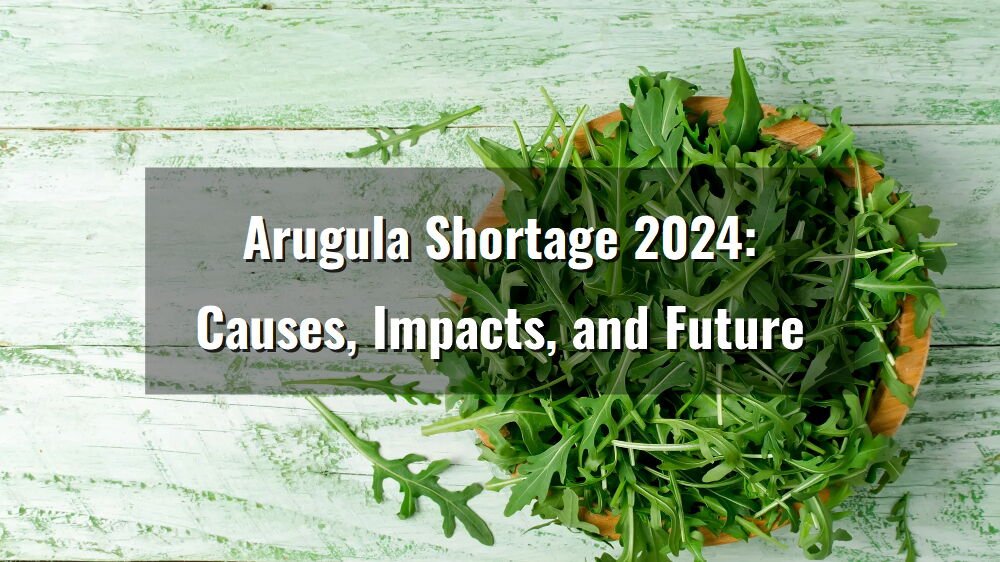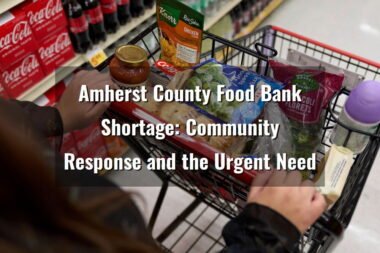Key Takeaways
- Adverse Weather Conditions: The 2024 arugula shortage was primarily driven by prolonged cold and wet weather, especially in major growing regions like California’s Imperial Valley and Yuma, Arizona.
- Fungal Diseases: Downy mildew, encouraged by damp conditions, damaged crops and reduced yields.
- Increased Demand: A surge in consumer interest in healthy, peppery greens strained an already vulnerable supply chain.
- Diverse Impacts: Supermarkets, restaurants, and even home gardeners experienced the effects, though localized microclimates sometimes led to personal gardening successes.
- Future Strategies: The shortage highlights the need for resilient agricultural practices, innovation in disease management, and diversified supply sources.
Referenced Links
- ABC News – National arugula shortage due to wet, cold growing conditions
- Unfold Business – Is There a Arugula Shortage in 2024?
- Markon – UPDATE SUMMARY: WEEK OF JANUARY 22, 2024
- Bent Business – Arugula Shortage in 2024: The Growing Demand
- Delish – A Nationwide Arugula Shortage May Affect Your Go-To Lunch
Introduction
Many consider 2024 a turning point in fresh vegetables, especially for arugula, a popular salad green. Arugula, often known as rocket or roquette, was in short supply in stores, restaurants, and even home kitchens due to its spicy taste. This article discusses the shortage’s causes, its effects on stakeholders, and the future of this vital green.
The arugula shortage was caused by multiple interconnected issues. Severe weather, rising consumer demand, and fungal infections were key. We’ll examine how nature, market patterns, and agricultural methods created a perfect storm for the arugula market as we examine the historical setting and 2024 event.
Historical Context
Arugula has always been delicate. In past years, like the 2020 shortage, unexpected cold snaps and protracted wet seasons had strained farmers’ endurance. 2024 presented more severe issues.
Stable circumstances are ideal for cool-season arugula, as farmers have long recognized. It is susceptible to sudden temperature and moisture changes due to its sensitive leaves and quick development. Health developments and culinary advances have raised market demand, complicating the 2024 shortfall. This historical perspective shows that weather-related issues are common, but they are accentuated when crop demand spikes.
Causes of the Shortage
The roots of the 2024 arugula shortage can be traced back to a combination of climatic and market-driven factors. The following table summarizes the primary reasons:
| Factor | Details |
|---|---|
| Adverse Weather | Extended periods of cold and wet weather disrupted growth cycles. Freezing temperatures in January 2024, especially in California’s Imperial Valley and Yuma, Arizona, slowed plant maturity. |
| Fungal Diseases | Downy mildew, a fungal disease, thrived under the wet conditions. The disease damaged leaves and reduced crop yields, echoing issues seen in previous years like 2020. |
| Increased Demand | The rising popularity of arugula as a healthful, flavorful salad green placed additional strain on the supply chain, leaving the market more vulnerable to production disruptions. |
Reports from early 2024, such as those from Markon, emphasized the role of freezing temperatures and highlighted that key growing regions faced unprecedented challenges. Similarly, Bent Business noted that the combination of adverse weather and a surge in demand led to significant supply issues.
Impacts on Stakeholders
The ripple effects of the arugula shortage were felt across the entire supply chain. Let’s break down the impacts on the major groups involved:
Supermarkets and Restaurants
Supermarkets struggled to keep their produce sections well-stocked. The limited availability of fresh arugula led to:
- Higher Prices: With supply dwindling, prices increased, pushing consumers to consider alternatives.
- Menu Adjustments: Restaurants had to adapt by modifying dishes or substituting arugula with other greens like spinach or kale.
- Supply Chain Disruptions: The sudden shortage forced suppliers to re-evaluate inventory management and sourcing strategies.
Consumers
For everyday shoppers, the shortage meant rethinking meal plans and experimenting with different greens. Many consumers turned to local farmer’s markets or even started growing their own produce at home. Interestingly, while commercial supplies dwindled, several home gardeners reported robust yields, suggesting that localized microclimates and individualized care practices can sometimes offset broader regional challenges.
Farmers and Growers
Farmers found themselves at a crossroads, facing the dual pressures of unpredictable weather and a booming demand for arugula. The reduced yields, compounded by crop diseases, meant that meeting commercial orders became increasingly challenging. This scenario has prompted discussions within the agricultural community about the need for:
- Better Disease Management: Exploring disease-resistant varieties and more resilient cultivation techniques.
- Improved Forecasting Tools: Leveraging technology to better predict and respond to weather variations.
- Diversification: Considering alternative crops or diversified production methods to buffer against similar shortages in the future.
Here’s a table summarizing the impacts on these key groups:
| Stakeholder | Impact | Response/Adaptation |
|---|---|---|
| Supermarkets | Stock shortages and increased prices | Adjusted inventory practices, sought alternative produce |
| Restaurants | Menu disruptions and need for ingredient substitutions | Modified recipes, explored different greens |
| Consumers | Reduced availability of fresh arugula, shifting to alternatives | Turned to local markets and home gardening |
| Farmers | Struggles to meet high demand amid lower yields | Investigating improved agricultural practices and diversification |
Broader Implications and Future Outlook
The 2024 arugula shortage serves as a case study on the fragility of agricultural supply chains in the face of climatic variability and market pressures. Here are some of the broader implications and potential future strategies:

Agricultural Vulnerability
This shortage underlines how susceptible specific crops can be to weather-related disruptions. Arugula, in particular, has shown that even crops considered resilient in cool seasons are not immune to unexpected climatic shifts. The events of 2024 make it clear that:
- Weather Extremes Are Increasing: With climate change influencing weather patterns, growers may face more frequent episodes of extreme conditions.
- Crop-Specific Vulnerabilities Need Addressing: Developing resilient strains and improving disease management will be critical moving forward.
Innovation in Farming Practices
The challenges faced by the arugula industry are prompting a re-evaluation of traditional farming methods. Potential innovations include:
- Vertical Farming: Utilizing indoor, controlled-environment agriculture to bypass unpredictable outdoor weather conditions.
- Hydroponics and Aeroponics: These soil-less cultivation techniques can reduce disease risks and improve yield consistency.
- Technology-Driven Forecasting: Incorporating advanced weather forecasting and real-time data analytics to better prepare for and respond to adverse conditions.
Supply Chain Diversification
Reliance on a few major growing regions has become a vulnerability. Diversifying the supply chain could include:
- Expanding Geographic Regions: Encouraging production in varied locations to buffer against regional weather events.
- Supporting Local Farmers: Investing in local agriculture can provide more stable supplies during national or international disruptions.
- Alternative Crops: Encouraging the production of similar leafy greens can help alleviate market pressure when one specific crop faces challenges.
Future Outlook
Moving forward, stakeholders in the arugula market are considering several adaptive strategies to mitigate future risks. The conversation now focuses on:
- Resilience and Sustainability: Emphasizing sustainable farming practices that reduce dependency on any single weather pattern.
- Consumer Communication: Enhancing transparency about supply challenges and educating consumers on the benefits of alternative greens.
- Policy and Support: Advocating for policies that support agricultural innovation and provide assistance during extreme weather events.
The lessons learned from the 2024 shortage are already influencing the dialogue among producers, distributors, and policy makers. There is a growing consensus that the agricultural sector must adapt to an era of climate uncertainty, employing a mix of traditional wisdom and modern technology to secure the future of essential crops like arugula.
FAQ
What caused the arugula shortage in 2024?
The shortage was mainly driven by a combination of prolonged cold and wet weather, which led to freezing temperatures in key growing regions, and the outbreak of downy mildew, a fungal disease. The situation was further exacerbated by a surge in demand for arugula as a popular salad green.
How did the weather affect arugula production?
Arugula is particularly sensitive to temperature fluctuations and moisture levels. In early 2024, freezing conditions in areas like California’s Imperial Valley and Yuma, Arizona, slowed plant growth and compromised quality. Additionally, persistent wet weather created an ideal environment for downy mildew, which damaged the crops and reduced overall yields.
What were the impacts on supermarkets and restaurants?
Supermarkets experienced limited arugula supplies, leading to higher prices and a shift towards alternative greens such as spinach or kale. Restaurants had to adjust their menus, often substituting arugula in their dishes. These adjustments not only affected product availability but also prompted a rethinking of supply chain management across the industry.
Why did some home gardeners report abundant arugula despite the shortage?
While commercial growers struggled with the widespread adverse weather, some home gardeners benefited from localized microclimates and personalized cultivation practices. These factors allowed for successful growth even when larger-scale production was affected by regional weather extremes and diseases.
What can be done to prevent future shortages?
Future strategies include developing disease-resistant varieties, diversifying growing regions, and adopting innovative farming techniques such as vertical farming and hydroponics. Enhanced weather forecasting and technology-driven agricultural practices can also help mitigate the risks associated with climate variability, ensuring a more stable supply chain.




